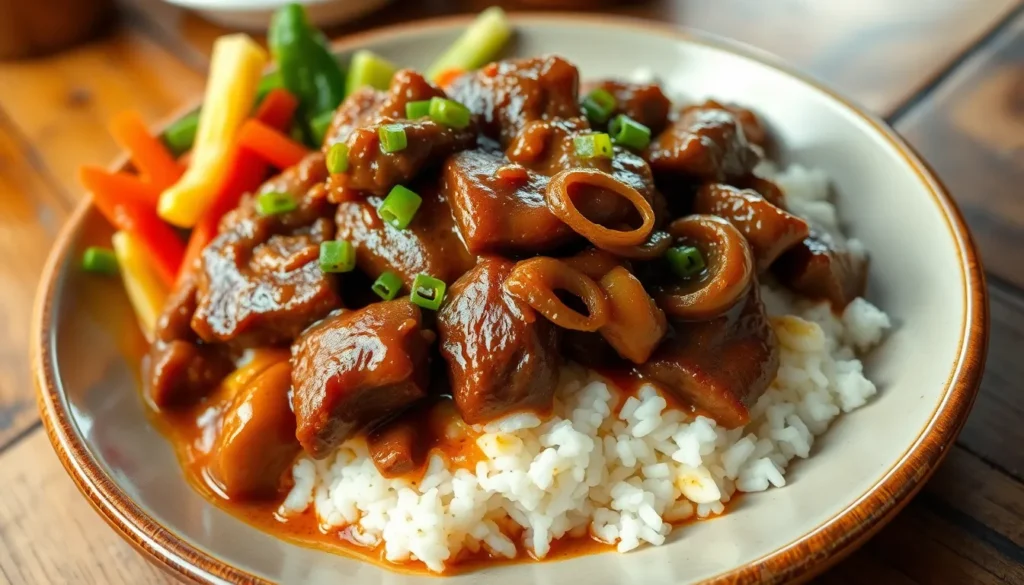We’ve all craved that perfect balance of sweet and savory flavors that makes Filipino cuisine so irresistible. Bistek Tagalog delivers exactly that – tender beef sirloin swimming in a rich soy sauce and calamansi marinade that’ll transport your taste buds straight to Manila.
This beloved Filipino comfort food transforms simple ingredients into something extraordinary. The magic happens when thinly sliced beef meets the tangy citrus kick of calamansi and the deep umami of soy sauce. Add those perfectly caramelized onions on top and you’ve got a dish that’s both elegant enough for special occasions and comforting enough for weeknight dinners.
We’re sharing our foolproof recipe that captures all the authentic flavors of this classic dish. Whether you’re new to Filipino cooking or looking to perfect your bistek game, this recipe will help you create restaurant-quality results right in your own kitchen.
What Is Bistek Tagalog
Bistek Tagalog stands as one of the Philippines’ most beloved comfort dishes that transforms simple beef into an extraordinary culinary experience. We define this classic recipe as thinly sliced beef sirloin marinated in a distinctive blend of soy sauce and calamansi juice before being pan-fried to perfection. The dish gets its signature flavor profile from this citrusy marinade that tenderizes the meat while infusing it with umami-rich depth.
Our traditional bistek features beef that soaks up the tangy marinade for hours, allowing the acidic calamansi to break down tough fibers naturally. Pan-frying creates beautiful caramelization on the meat’s surface while keeping the interior incredibly tender. The cooking process builds layers of flavor as the marinade reduces into a glossy sauce that coats each piece of beef.
Caramelized onions serve as the dish’s crowning element, adding sweetness that balances the salty soy sauce and tart calamansi perfectly. We slice these onions into rings and cook them until they reach a golden brown color that complements the beef’s rich appearance. The onions also contribute a subtle sweetness that rounds out the dish’s complex flavor profile.
Regional variations of bistek tagalog exist throughout the Philippines, with some cooks adding garlic or black pepper to enhance the marinade. Northern provinces sometimes incorporate local citrus fruits when calamansi isn’t available. Urban households often streamline the recipe for weeknight dinners while maintaining the essential flavor components that make this dish so special.
Ingredients

Creating our authentic Bistek Tagalog requires carefully selected ingredients that work together to build the dish’s signature flavor profile. We’ve organized these components into three essential categories to streamline your preparation process.
For the Beef
- 1 to 1.5 lbs beef sirloin or ribeye, thinly sliced
- Alternative cuts: flank steak or skirt steak
We recommend beef sirloin or ribeye for their tender texture and rich flavor that pairs beautifully with our marinade. Slicing the meat thinly ensures quick cooking and maximum marinade absorption. Flank or skirt steak serves as excellent budget-friendly alternatives that deliver comparable results when properly prepared.
For the Marinade
- 5 to 8 tablespoons soy sauce (dark or regular soy sauce; tamari for gluten-free option)
- Juice of 4 calamansi or 1 lemon (calamansi preferred for authentic flavor)
- 1/2 teaspoon ground black pepper
- 3 cloves garlic, minced (optional)
- 1 teaspoon sugar (white, brown, or coconut sugar – optional for balancing acidity)
Our marinade combines the essential umami depth of soy sauce with the bright citrus notes that define Bistek Tagalog. Calamansi juice provides the most authentic flavor profile, though fresh lemon or lime juice works as effective substitutes. Adding a touch of sugar helps balance the marinade’s acidity while the black pepper contributes subtle heat and complexity.
For Cooking
- 2 large onions, sliced into rings (sweet onions preferred)
- Cooking oil (avocado oil or neutral high smoke point oil)
- 1 tablespoon cornstarch mixed with 2 tablespoons water (for sauce thickening)
- Beef stock or water as needed (for sauce consistency adjustment)
Sweet onions create the perfect caramelized base that complements our beef’s savory elements. We use high smoke point oils like avocado oil to achieve proper searing without burning. The cornstarch slurry transforms our pan drippings into a glossy sauce that coats every piece of beef beautifully.
Equipment Needed

Creating perfect Bistek Tagalog requires the right tools to ensure each step flows smoothly from preparation to plating. We’ve compiled the essential equipment that will help you achieve restaurant-quality results in your home kitchen.
Essential Preparation Tools
Cutting board and sharp knife form the foundation of our prep work. We recommend using a sturdy wooden or plastic cutting board paired with a well-sharpened chef’s knife for slicing beef thinly and creating uniform onion rings. The precision of your cuts directly impacts the final texture and presentation of your dish.
Mixing bowls serve multiple purposes throughout the cooking process. We suggest having at least two medium-sized bowls: one for marinating the beef and another for preparing the sauce mixture. Stainless steel or glass bowls work best as they don’t absorb flavors or odors.
Resealable ziplock bags or airtight containers ensure proper marination of your beef. We prefer using gallon-sized ziplock bags because they allow the marinade to coat every piece of meat evenly while taking up minimal refrigerator space.
Precision Measuring Equipment
Measuring cups and spoons guarantee consistent flavor balance in every batch. We recommend having both liquid and dry measuring cups on hand, along with a complete set of measuring spoons for accurate seasoning portions.
Cooking Equipment
Large skillet or frying pan serves as the star of our cooking setup. We prefer using a 12-inch non-stick or well-seasoned cast iron pan that provides even heat distribution and prevents the beef from sticking. The wide surface area allows proper searing without overcrowding.
Tongs or spatula help us handle the delicate beef slices without piercing them. We recommend using long-handled tongs for better control and safety when working with hot oil and sizzling beef.
Plate and paper towels provide a staging area for our cooked components. We use these to drain excess oil from the beef and keep ingredients organized throughout the cooking process.
Your stove or heat source should offer reliable temperature control for both high-heat searing and gentle simmering phases of the recipe.
| Equipment Category | Essential Items | Optional Upgrades |
|---|---|---|
| Prep Tools | Sharp knife, cutting board, mixing bowls | Mandoline slicer, wooden spoons |
| Storage | Ziplock bags, airtight containers | Vacuum sealer, glass containers |
| Cooking | Large skillet, tongs, measuring tools | Cast iron pan, digital thermometer |
| Serving | Plates, paper towels | Warming plates, serving platter |
Having these tools ready before you begin ensures a smooth cooking experience and helps you focus on perfecting the flavors rather than searching for equipment mid-recipe.
Instructions
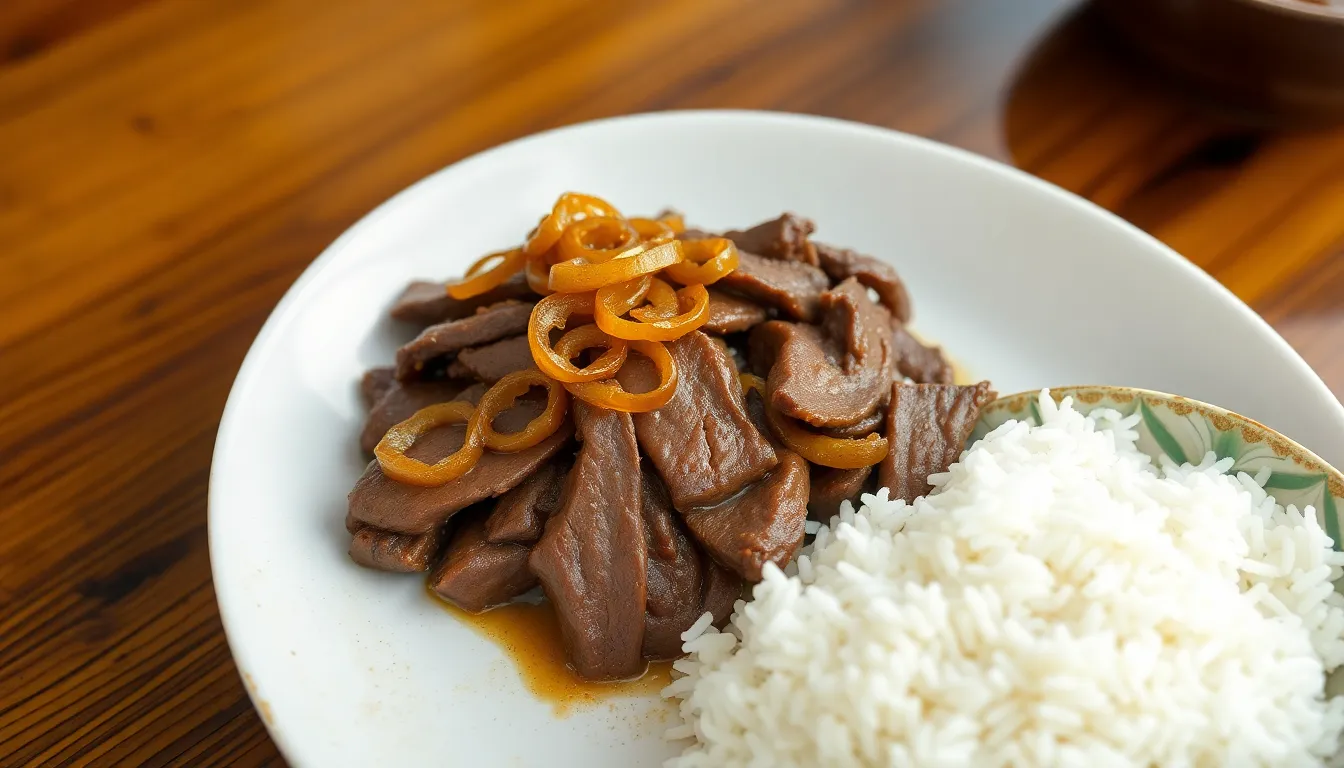
Now we’ll walk through the step-by-step process to create this authentic Filipino beef steak. Each stage builds upon the previous one to develop the signature flavors that make Bistek Tagalog so beloved.
Prep the Beef
We begin by slicing our beef sirloin or round cut into thin pieces, approximately ¼ inch thick. The thin slicing technique helps the meat absorb marinade flavors effectively while ensuring quick cooking. Using a meat mallet, we lightly tenderize each beef slice to break down the muscle fibers. This gentle pounding creates tenderness without shredding the meat structure. Pat the beef slices dry with paper towels before proceeding to marination.
Marinate the Beef
We combine soy sauce, calamansi juice (or lemon juice as substitute), and ground black pepper in a mixing bowl to create our marinade base. Place the tenderized beef slices into a ziplock bag and pour the marinade over them. Remove excess air from the bag to maximize flavor infusion between the marinade and meat. For optimal results, we marinate the beef for at least 1 hour, though overnight marinating delivers deeper flavor penetration. Reserve the used marinade liquid as we’ll incorporate it into our sauce later.
Cook the Onions
We slice sweet onions into rings, maintaining consistent thickness for even cooking. Heat cooking oil in our large skillet over medium-high heat until shimmering. Sear the onion rings until they develop a golden brown color on one side. For authentic texture and taste, we add onions near the cooking process end and simmer them briefly. This technique keeps the onions crisp yet slightly cooked, providing the perfect contrast to our tender beef.
Cook the Beef
Remove the marinated beef from the ziplock bag, allowing excess marinade to drip off while preserving the liquid for our sauce. Heat oil in the same pan over high heat until it reaches proper searing temperature. Sear the beef slices until they develop a beautiful brown color with slight charring for enhanced flavor depth. Cook the beef in batches if necessary to avoid overcrowding, which can cause steaming instead of proper searing. Set the cooked beef aside while we prepare the sauce base.
Assemble and Simmer
Lower the heat to medium and add minced garlic to our pan, sautéing until fragrant. Pour in the reserved marinade, along with additional soy sauce, calamansi juice, and a pinch of sugar for flavor balance. Bring the mixture to a boiling point, then reduce to a gentle simmer for several minutes. Create a cornstarch slurry by mixing cornstarch with water, then gradually stir it into our sauce until it reaches the desired thickness. Return the seared beef and cooked onions to the pan, gently folding them into the glossy sauce. Heat everything through for 2-3 minutes, ensuring the beef is coated evenly with our flavorful sauce before serving hot with steamed jasmine rice.
Cooking Tips for Perfect Bistek Tagalog
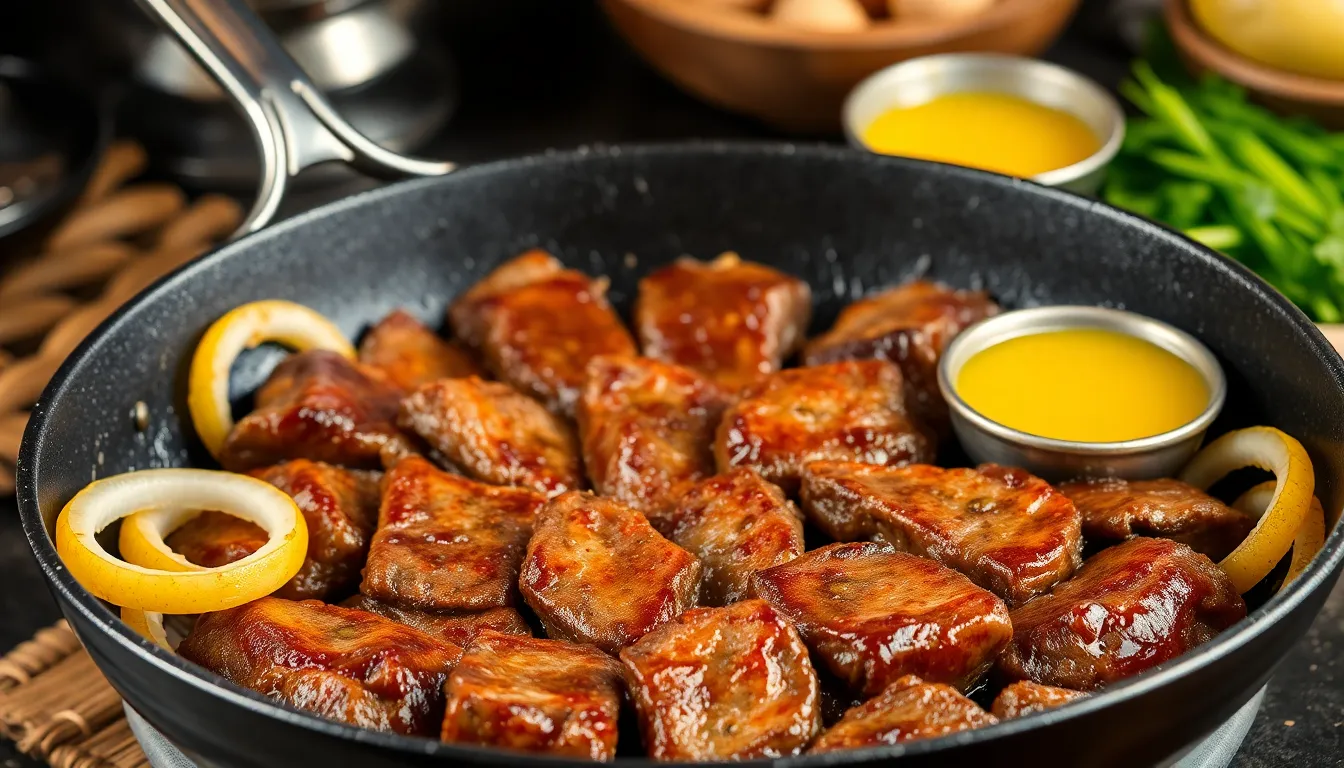
Mastering the beef preparation begins with properly handling the marinade before cooking. We squeeze the marinade well from beef slices and pat them completely dry before searing to achieve that coveted golden crust. This crucial step prevents steaming and ensures beautiful caramelization develops on each piece.
Heat management transforms ordinary beef into restaurant quality results. Brown your beef on high heat while avoiding overcrowding the pan to guarantee even searing across all surfaces. We recommend cooking in batches if necessary to maintain proper spacing between pieces.
Fresh onion rings elevate both flavor and visual appeal significantly. We use sweet onions sliced into perfect rings as garnish rather than relying on pre-cut alternatives for superior taste and presentation.
Authentic citrus makes all the difference in flavor development. Calamansi juice delivers the traditional Filipino taste profile we’re seeking. Lemon or lime serve as suitable substitutes when calamansi isn’t available in your local market.
Time investment in marination pays substantial dividends in taste. We marinate beef overnight whenever possible to allow enhanced flavor infusion throughout each slice. This extended marination period creates deeper umami complexity that elevates the entire dish.
Sauce preparation requires strategic thinking about flavor concentration. Let marinade drain completely before cooking but save every drop for sauce preparation to maximize flavor impact. We never waste this liquid gold that carries all those beautiful marinated flavors.
| Cooking Technique | Time Required | Result Achieved |
|---|---|---|
| Beef marination | 1 hour minimum, overnight preferred | Enhanced flavor infusion |
| Beef searing | 2-3 minutes per side | Golden crust development |
| Onion cooking | 5-7 minutes | Soft, translucent texture |
| Sauce simmering | 2-3 minutes | Proper thickening consistency |
Pan temperature control ensures consistent results every cooking session. We heat oil until it shimmers before adding beef to guarantee immediate searing action begins. This technique locks in juices while creating that signature caramelized exterior Filipino cooks prize.
Serving Suggestions
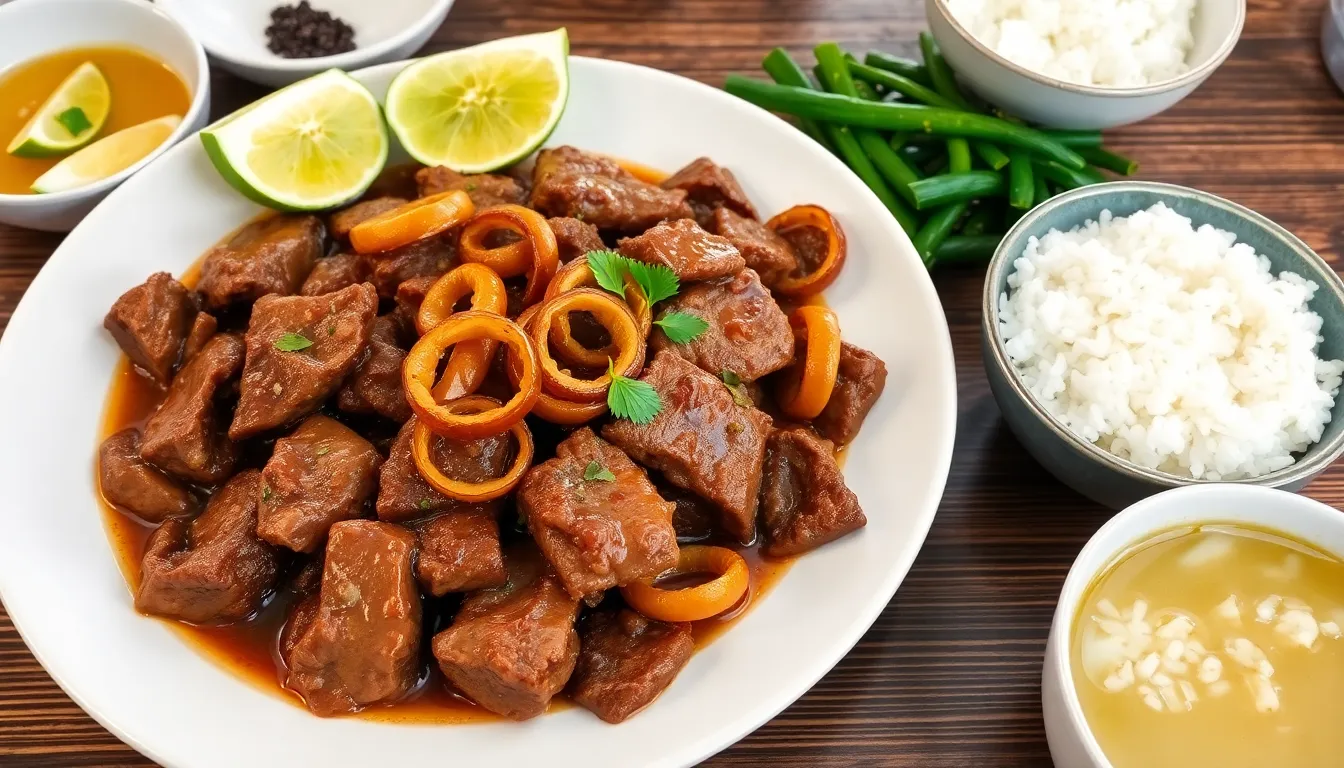
We recommend serving Bistek Tagalog immediately while hot over steamed white rice to capture the full essence of this Filipino classic. The fluffy jasmine rice acts as the perfect canvas for soaking up the rich, tangy sauce that coats each tender piece of beef.
Traditional Filipino dining calls for family-style presentation where we place the Bistek Tagalog on a large serving platter alongside individual bowls of steamed rice. This approach allows everyone to appreciate the beautiful caramelized onion rings that crown the dish while the aromatic steam carries the savory soy and citrus notes throughout the dining area.
We find that simple vegetable accompaniments complement the bold flavors without competing for attention. Sautéed kangkong (water spinach) or blanched green beans provide a fresh contrast to the rich beef. Pickled vegetables like atchara (pickled papaya) cut through the richness while adding textural variety to each bite.
Fresh calamansi wedges serve as essential table companions that we always include with our presentation. Guests can squeeze additional citrus juice over their portions to brighten the flavors according to their taste preferences. This customizable element makes the dish appealing to different palates within the same meal.
We suggest pairing Bistek Tagalog with a light soup such as clear broth with vegetables or a simple egg drop soup. These gentle accompaniments cleanse the palate between bites while maintaining the focus on the star dish. The combination creates a well-rounded Filipino meal that satisfies without overwhelming the senses.
For special occasions we elevate the presentation by arranging the beef strips in an overlapping pattern and carefully placing the golden onion rings in a decorative formation on top. A sprinkle of freshly chopped scallions adds color contrast while reinforcing the fresh elements that make this dish so memorable.
Storage Instructions
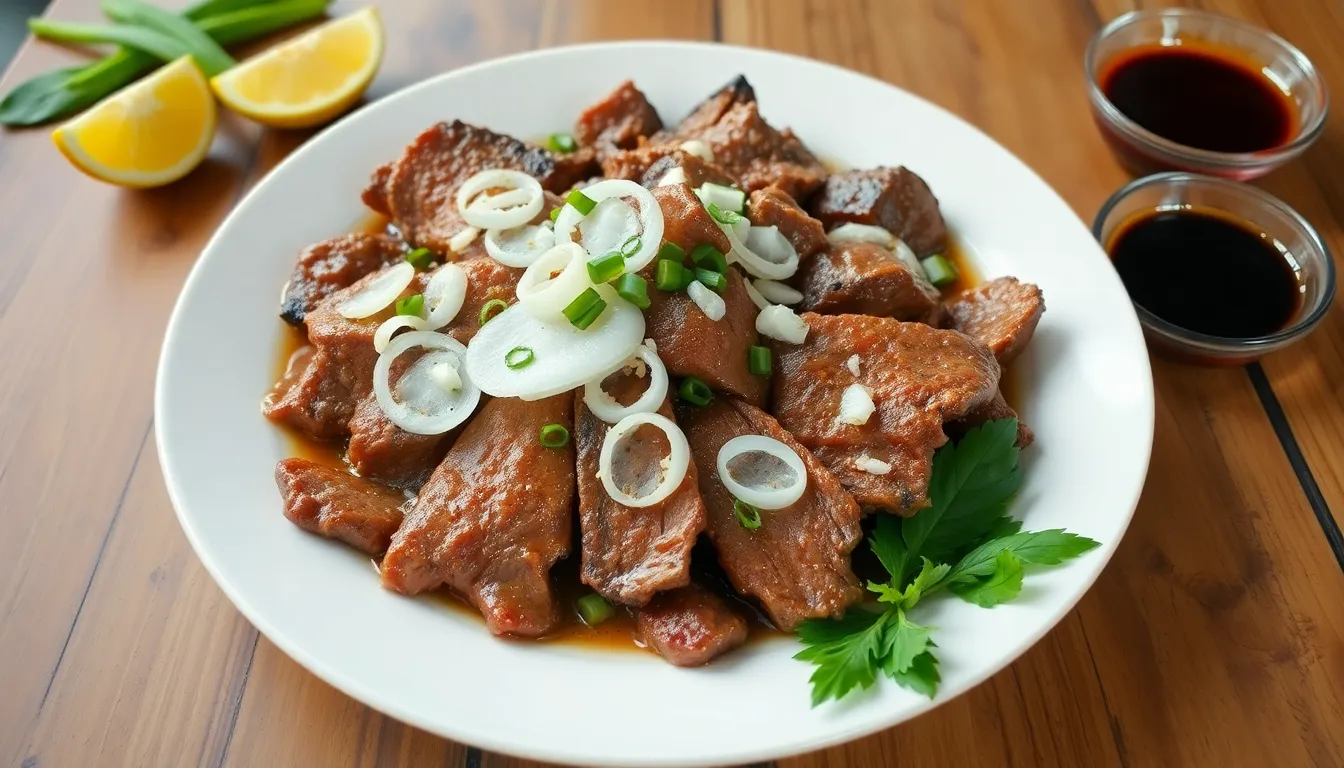
Proper storage keeps your delicious Bistek Tagalog fresh and safe for future meals. We’ll show you the best methods to maintain that rich flavor and tender texture when storing leftovers.
Refrigerator Storage
Transfer your cooled Bistek to an airtight container with a secure lid immediately after cooking. Store the dish in the refrigerator for up to 3 to 5 days for optimal freshness and food safety.
Keep the beef together with the onions and sauce during storage to retain moisture and prevent the meat from drying out. This method preserves the signature flavors that make Bistek Tagalog so appealing.
We recommend letting the dish cool completely before refrigerating to prevent condensation buildup inside the container. Label your container with the storage date to track freshness easily.
Freezer Storage
Place your completely cooled Bistek in a freezer-safe airtight container for longer storage periods. Freeze the dish for up to 3 months to maintain quality and prevent freezer burn.
Ensure the container is well sealed before freezing to protect the flavors from freezer odors. We suggest portioning the Bistek into meal-sized containers for convenient thawing and reheating.
Leave some space at the top of the container since liquids expand when frozen. This prevents the container from cracking and maintains the integrity of your stored dish.
Reheating Tips
Reheat your Bistek on the stovetop over medium-low heat until warmed through completely. Add a splash of water or beef stock if the sauce has thickened or dried out during storage.
Microwave reheating works well using 30-second intervals while stirring between each interval for even heating. This method prevents hot spots and ensures the beef heats uniformly.
Restore moisture and flavor by adding more soy sauce, calamansi juice, or water if the reheated beef appears too dry. Avoid overheating to prevent the beef from becoming tough and chewy.
Recipe Variations
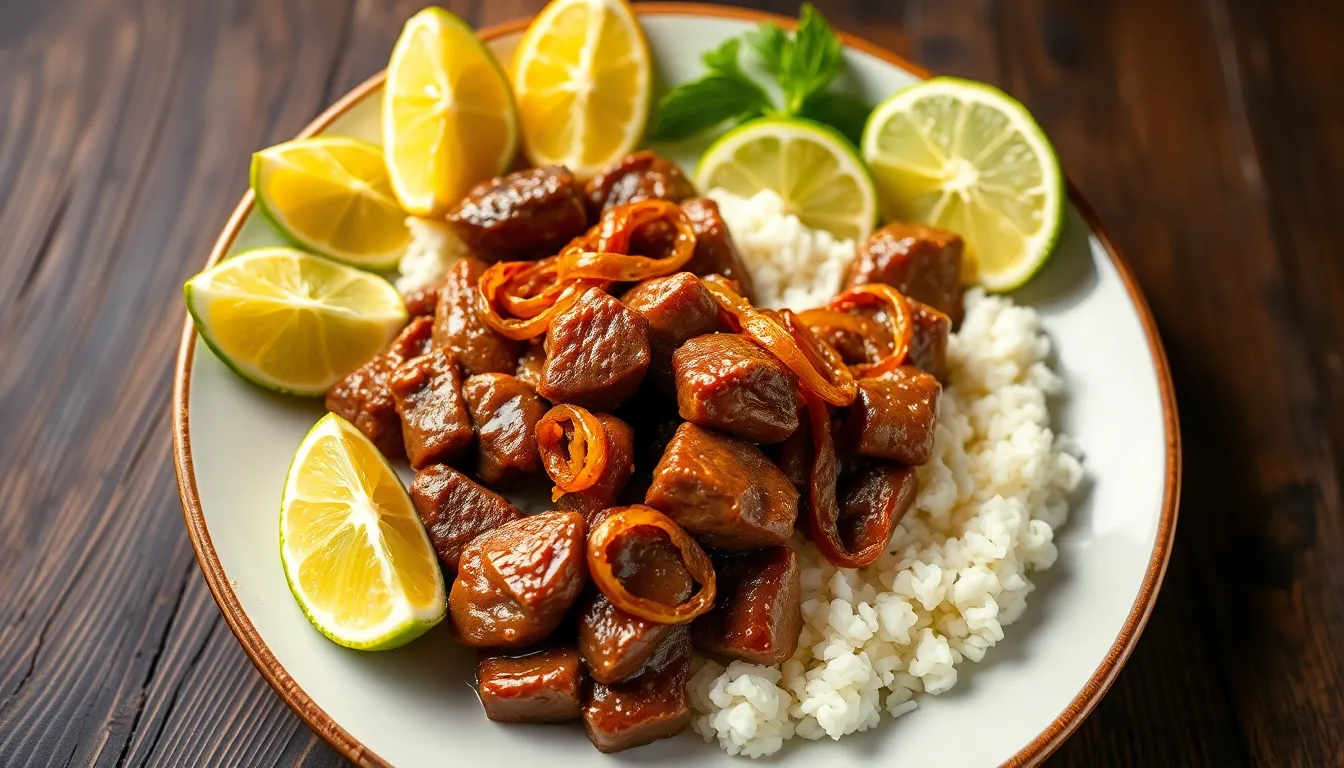
We love how adaptable Bistek Tagalog becomes when you explore different ingredients and techniques. Our traditional recipe serves as the perfect foundation for creative modifications that suit various preferences and ingredient availability.
Meat Selection Options
Ribeye remains our top choice for its marbling and tenderness, but we frequently use more budget-friendly alternatives. Skirt steak delivers excellent texture and affordability while maintaining authentic flavor absorption. Flank steak works beautifully when sliced against the grain for maximum tenderness. We recommend pounding any cut lightly with a meat mallet to ensure consistent texture throughout the dish.
Citrus Alternatives
Authentic calamansi provides the signature tang that defines Bistek Tagalog, yet we understand this citrus isn’t always available. Fresh lemon juice creates a bright acidity that closely mimics calamansi’s flavor profile. Lime juice offers a slightly different but equally delicious tartness. We suggest using a 1:1 ratio when substituting either citrus for calamansi in your marinade.
Sauce Modifications
Our basic sauce recipe welcomes several enhancements for deeper flavor complexity. Adding a splash of beef stock during simmering creates more sauce volume and richness. We often incorporate an extra squeeze of calamansi juice near the end of cooking for enhanced tanginess. Some cooks prefer adding a tablespoon of water to thin the sauce consistency while maintaining concentrated flavors.
Onion Preparation Styles
Golden caramelized onions provide the classic Bistek experience we all know and love. We sometimes prefer keeping onions slightly crisp and less cooked for added crunch and bite. Ring-cut onions create beautiful presentation while strips blend more seamlessly with the beef. Timing becomes crucial here since adding onions at the end preserves their texture and prevents overcooking.
Aromatic Enhancements
Garlic transforms the dish when added to either the marinade or cooking sauce. We include minced garlic directly in our marinade for deeper flavor penetration. Fresh garlic cloves sautéed with onions create wonderful aromatic layers. Ground black pepper variations range from fine to coarsely cracked depending on your heat preference and texture desires.
Conclusion
We’ve shared everything you need to master this beloved Filipino dish that transforms simple ingredients into something truly extraordinary. The beauty of Bistek Tagalog lies in its simplicity and the way each component works together to create layers of flavor.
Whether you’re cooking for your family or introducing friends to Filipino cuisine this recipe delivers authentic taste every time. The tender beef paired with that glossy savory-sweet sauce makes for a meal that’s both comforting and impressive.
Don’t hesitate to make this dish your own by experimenting with the variations we’ve discussed. From different cuts of beef to citrus alternatives the possibilities are endless while keeping that traditional Bistek flavor profile intact.
Fire up your skillet and get ready to enjoy one of the Philippines’ most cherished comfort foods right in your own kitchen.
Frequently Asked Questions
What is Bistek Tagalog?
Bistek Tagalog is a beloved Filipino comfort dish featuring tender beef sirloin marinated in soy sauce and calamansi juice. The meat is pan-fried and served with caramelized onions in a glossy, savory-sweet sauce. This classic dish combines umami-rich flavors with a perfect balance of sweet and savory elements, making it suitable for both special occasions and casual family dinners.
What cut of beef is best for Bistek Tagalog?
The best cuts for Bistek Tagalog are thinly sliced beef sirloin or ribeye, using 1 to 1.5 lbs total. These cuts provide the ideal tenderness and flavor. For budget-friendly alternatives, flank steak or skirt steak work well. The key is slicing the beef thinly against the grain to ensure maximum tenderness after marinating and cooking.
Can I substitute calamansi juice in the recipe?
Yes, you can substitute calamansi juice with fresh lemon or lime juice. Use the same amount called for in the recipe. While calamansi provides a unique Filipino citrus flavor, lemon juice is the closest substitute and will still tenderize the meat effectively while adding the necessary acidity to balance the soy sauce’s saltiness.
How long should I marinate the beef?
For optimal flavor infusion, marinate the beef overnight or at least 4-6 hours. The marinade contains soy sauce and citrus juice that tenderize the meat while infusing it with umami depth. Longer marination times result in more flavorful and tender beef. Always marinate in the refrigerator and handle the marinade safely to prevent contamination.
What’s the secret to perfect caramelized onions?
The secret to perfect caramelized onions is using sweet onions and cooking them slowly over medium heat until golden brown. Don’t rush the process – properly caramelized onions develop natural sweetness that complements the savory beef. Cook them separately from the beef to control their texture and prevent overcooking while maintaining their shape and flavor.
How do I prevent the beef from becoming tough?
To prevent tough beef, slice it thinly against the grain and don’t overcook it. Marinate overnight for maximum tenderness, then pan-fry quickly over medium-high heat for caramelization while keeping the interior tender. Avoid cooking too long, as the beef can become chewy. The marinade’s acidity helps break down tough fibers naturally.
Can I make Bistek Tagalog ahead of time?
Yes, Bistek Tagalog can be prepared ahead and stored in the refrigerator for 3-5 days or frozen for up to 3 months. The flavors actually improve after resting. When reheating, do so gently over low heat to prevent the beef from becoming tough. Add a splash of water if the sauce becomes too thick during storage.
What should I serve with Bistek Tagalog?
Serve Bistek Tagalog immediately over steamed white rice, which absorbs the flavorful sauce perfectly. Present it family-style with simple vegetable accompaniments like steamed broccoli or green beans. The rice is essential as it balances the dish’s rich, savory flavors and makes it a complete, satisfying meal for the whole family.
Can I adjust the sauce thickness?
Yes, you can adjust the sauce thickness using a cornstarch slurry (cornstarch mixed with water). Add it gradually while cooking to reach your desired consistency. For a thinner sauce, add a little water or beef broth. For a thicker, glossy sauce that coats the beef beautifully, use the cornstarch slurry technique mentioned in the recipe.
What are common variations of this recipe?
Common variations include adding extra garlic or black pepper for aromatics, using different onion preparation styles for texture, and modifying the sauce with additional seasonings. Some regions add sugar for extra sweetness, while others incorporate different citrus combinations. The recipe is highly adaptable while maintaining its authentic Filipino flavors and traditional cooking methods.

